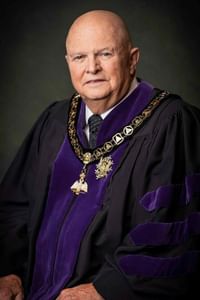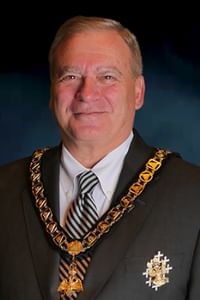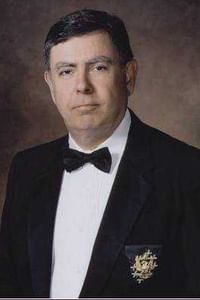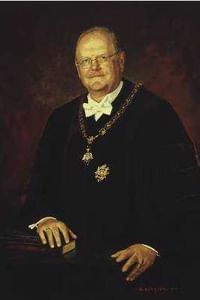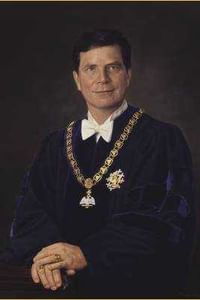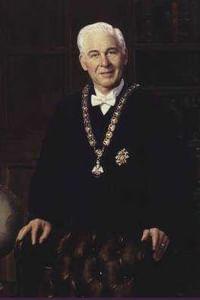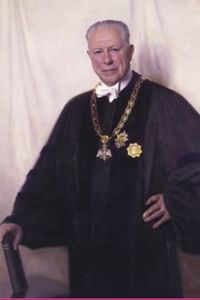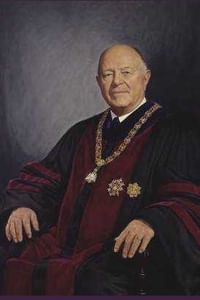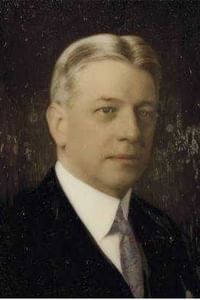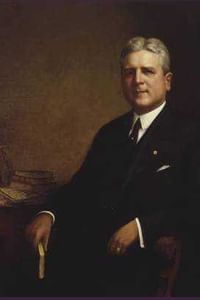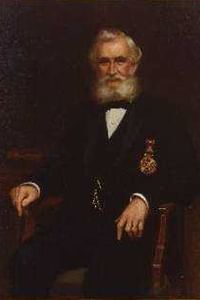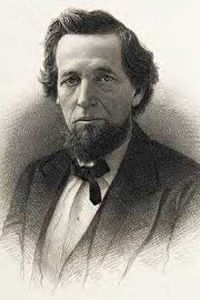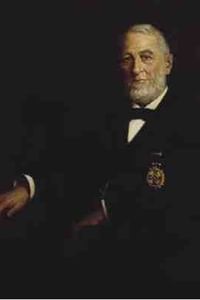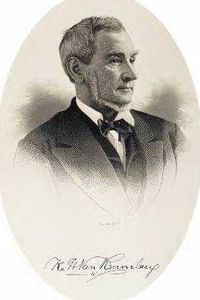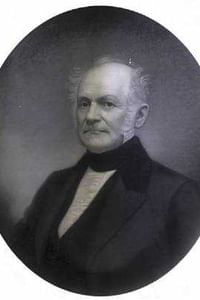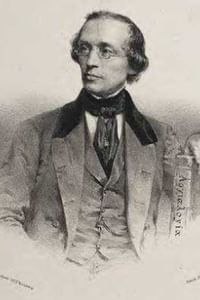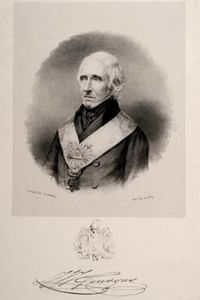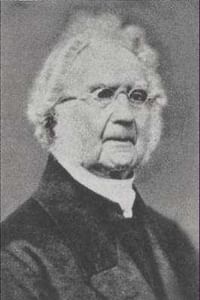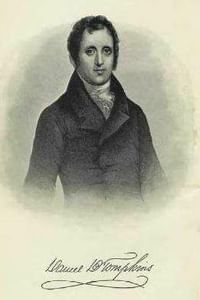
The Office of Sovereign Grand Commander
We invite you to travel the halls of history alongside Sovereign Grand Commander Wheeler as we learn more of the stories behind the men that have served at the helm of the Ancient Accepted Scottish Rite for the Northern Masonic Jurisdiction of the United States of America. This journey begins back in 1813 as we first meet Daniel Decius Tompkins and spans the 23 men that have held this office.
-
Walter F Wheeler (b. 1956)
Sovereign Grand Commander, 2023-Present
Commander Wheeler began his journey as a member of Grand Rapids Chapter, Order of DeMolay in 1970. He served as Master Councilor in 1973 and District Master Councilor of District #4 in 1974. He is a holder of the degree of Chevalier, as well as the DeMolay Legion of Honor. In 2012 he was inducted into the Michigan DeMolay Hall of Fame. He is an Active member of the DeMolay International Supreme Council. He is also a recipient of the Grand Cross of Honor from International Order of Rainbow for Girls and the Grand Triangle of Honor from Job’s Daughters International.
Commander Wheeler was raised a Master Mason in Grand River Lodge #34 (now Grand Rapids Lodge #34) in 1977 and served as Worshipful Master in 1985. He served the Grand Lodge of Michigan as Grand Master from 2006-2007 and Grand Treasurer from 2007-2010. He holds Honorary Membership in 25 Michigan Lodges. He is an Honorary Past Grand Master of the Grand Lodge of New Jersey. Commander Wheeler served as the Executive Director/CEO for the Michigan Masonic Charitable Foundation from 2009-2020.
He has been a Scottish Rite Mason since 1980 and is a member of the Valley of Michigan. He was coroneted a Sovereign Grand Inspector General, 33°, Honorary member of the Supreme Council in 1997 in Grand Rapids. He served as Sovereign Prince of Cyrus Council Princes of Jerusalem in 1994-95, Commander-In-Chief of DeWitt Clinton Consistory in 2001-2002 and in 2009, was Thrice Potent Master in Moriah Lodge of Perfection.
He twice served as President of the Board of Trustees of the Valley of Grand Rapids, and from 2011-2020, he served on the Board of Directors for the Children’s Learning Centers. He is a Past President of the Grand Rapids Scottish Rite Club, and a holder of the Valley’s Thespian Award for distinguished service in the degree work of the Valley.
Commander Wheeler was made an Active Member of the Supreme Council in Boston in 2009.
Commander Wheeler is a member of all York Rite bodies and is a holder of the Knight York Cross of Honor (KYCH). He is a Past Puissant Sovereign or St. Vincent’s Conclave of the Red Cross of Constantine, and a Past Sovereign Master of Mt. Moriah Council of the Allied Masonic Degrees. He is also a member of the York Rite Sovereign College, Shriners International, Eastern Star, High Twelve International, the Rosicrucian’s, and the Grotto (M.O.V.P.E.R.)
During his professional career, Commander Wheeler was a partner in several businesses in Michigan, including 2 bowling centers, 2 restaurants/lounges, a real estate holding company, a trucking company, and a marketing company.
He met his wife, Vickie, at a DeMolay Installation in 1972. At the time Vickie was a member of Job’s Daughters Bethel #67 in Grandville, Michigan. They have been happily married since 1976 and have three sons: Andrew, Justin, and Tyler and 5 grandchildren.
-
Peter John Samiec (b. 1947)
Sovereign Grand Commander, 2021-Present
Ill. Brother Samiec was raised a Master Mason at St. Patrick’s Lodge No. 4 in Johnstown, New York in 1982, where he served as Worshipful Master in 1991, the year of the lodge’s 225th anniversary. He affiliated with Gloversville Lodge No. 429 in 1985, serving as Master for two terms. He is also a member of Amsterdam Lodge No. 84 and Kosciuszko Lodge #1085.
On November 6, 1982, he was created a Sublime Prince of the Royal Secret in Sigma Consistory, Valley of Schenectady, New York, where he served as Commander-in-Chief for Sigma Consistory from 1995-1997. In 1991, he received the Meritorious Service Award at the NYS Council of Deliberation. He has served on numerous Valley committees and was Deputy for New York from 2008-13.
Ill. Brother Samiec was coroneted a Sovereign Grand Inspector General, 33° Honorary Member of the Supreme Council in Cincinnati, Ohio, on September 29, 1998. He was crowned an Active Member of Supreme Council in 2003. He has served as Grand Lieutenant Commander under both Commander John William McNaughton and Commander David A. Glattly. He has served as the Grand Almoner since 2015. Ill. Brother Samiec was installed as Sovereign Grand Commander in Cleveland on August 31, 2021.
In addition to Ill. Brother Samiec’s active service to the Scottish Rite, NMJ and Supreme Council, he is a member of York Rite, as well as several Masonic Lodges of Research.
Illustrious Bro. Peter J. Samiec, 33°, was born and raised in the great state of New York. He was educated in the Batavia City School System and graduated with a Regents Diploma. He then went on to the State University College at Buffalo, earning a Bachelor of Science degree in education. He also holds a master’s degree in Educational Philosophy and Clinical Educational Supervision from the State University College at Oneonta, New York.
Ill. Brother Samiec and his lovely wife, Gail P. Randall, have been married for 53 years and they are the proud parents of Dr. Carrie B. Samiec and also have a grandson, Nathan.
Brother Samiec, 33°, served as a technology education instructor at the Gloversville Enlarged School System in Gloversville, New York. He served as part of the middle school technology team for 22 years, where he developed a program that integrated the teaching of reading into the technology curriculum, providing reinforcement of reading skills in a nontraditional environment.
In 1990, Ill. Brother Samiec was transferred to the high school level, teaching technical mathematics and automotive technology. He was appointed department chair in 1991, serving in that capacity until his retirement in June of 2001. He was selected as Teacher of the Year in 2001 by the Fulton-Montgomery Regional Technology Teachers Association and New York State Technology Educators Association. He also served as an adjunct professor in the Communications Technology Department at Fulton-Montgomery Community College.
After his retirement, Ill. Bro. Samiec devoted his time to the operation of his business, Subcontracting Services Co., specializing in installing and servicing residential electrical, lighting, and communications systems.
He enjoys 1960s-era automotive technology, collecting diecast auto replicas, landscape and wildlife photography, and Buffalo Bills football.
-
David Alan Glattly (b. 1953)
Sovereign Grand Commander, 2017-2021
David A. Glattly, Sovereign Grand Commander of the Scottish Rite, NMJ, describes himself as “just a DeMolay boy from Clifton, New Jersey.” He was born in Paterson, NJ, on August 10, 1953, but grew up in Clifton, where he lived up to and including his college years.
Although both his father and grandfather were members of the Craft, Ill. Bro. Glattly entered the Masonic world through DeMolay. He Joined Clifton DeMolay Chapter in 1970 and served as Master Councilor. Four years later he was raised a Master Mason in Clifton Lodge No. 203. In 1995 he was chosen as Master of the lodge.
Ill. Bro. Glattly joined Scottish Rite in 1987 and then in 2000, in Pittsburgh, he received the 33°. He explains that, “In that year as a Millennium project each Valley reached out for candidates doing Masonic work in many fields. I was chosen for my concentration on DeMolay.” He remained – and still remains – active with that group. He served as Grand Marshal of the Grand Lodge of New Jersey in 1998, was Executive Officer of DeMolay from 1999-2004, and has earned six Grand Master of DeMolay Eagle Awards – the most recent being a lifetime achievement award.
Ill. Bro. Glattly has received several other Masonic honors including the Daniel Coxe Medal from New Jersey and the Josiah Drummond Award from Maine. During Hurricane Sandy, Bro. Glattly was point man for the Scottish Rite as the fraternity provided relief for so many of our members during that tragedy.
On July 7, 1990, he married Monica, and said, “She has been a partner in everything I do since then.” They have two children – a son, Matthew, and a daughter, Jessica. As far as his views on his role as Grand Commander, he said: “I plan to follow the vision statement. We will not change course, and we will focus on increasing membership." Commander Glattly helped achieve just that -- and in the midst of a global pandemic no less. In partnership with Scottish Rite, Southern Jurisdiction and Shriners International, Scottish Rite, NMJ launched BeAFreemason.org, which serves as a first-of-its-kind digital "front door to Freemasonry" -- where interested men can learn more about Freemasonry from the comfort of their own homes. From the site’s initial launch on March 1, 2020 to the following year, Grand Lodges fielded nearly 10,000 leads from the site.
-
John William McNaughton (b. 1950)
Sovereign Grand Commander, 2006–2017
A native of Fort Wayne, Indiana, Sovereign Grand Commander McNaughton graduated from Indiana University with a degree in forensic studies, and spent the next 10 years as a detective with the Fort Wayne Police Department. He then joined his father — Illustrious John Willard McNaughton, 33°, an Active Emeritus member of the Supreme Council — in operating the All Rite Distributing Company, Inc.
He and his wife, Judy, have been married since 1971. They have two children, Michelle Marie Sellers, and Illustrious Brother John Brian McNaughton, 33°.
A Freemason since 1974, Illustrious Brother McNaughton served as Worshipful Master of Maumee Lodge No. 725, Fort Wayne, Indiana. In the Scottish Rite Valley of Fort Wayne, he presided as Thrice Potent Master of Fort Wayne Lodge of Perfection beginning in 1996. He became an Active Member of Supreme Council in 1998. He is a member of the York Rite in Fort Wayne and Mizpah Shrine.
Grand Commander McNaughton rose rapidly through the ranks of the Scottish Rite. He received the 33° in 1997; became an Active Member for Indiana in 1998; served on several key committees within the Supreme Council; became Grand Lieutenant Commander, and as such, due to the debilitating illness of Sovereign Grand Commander Webber, conducted the Annual Meeting in Grand Rapids, Michigan, in 2005.
On August 28, 2006, Past Sovereign Grand Commander, Illustrious Robert O. Ralston, 33°, installed into office duly elected Sovereign Grand Commander, Illustrious John William McNaughton, 33°.
During his tenure, he has displayed his business and managerial acumen by establishing a sound financial footing for the 32° Masonic Learning Centers for Children, now the Children’s Dyslexia Centers, and the Scottish Rite Masonic Museum & Library. Grand Commander McNaughton was very attentive to fiscal responsibility during the challenges of the nation’s economic recession during his first triennial term. He also streamlined ceremonies; began work on degree revisions; oversaw production of a video presentation of the new 4° and others; insisted that Scottish Rite events be inspirational, convenient and enjoyable; focused the charitable endeavors of the Scottish Rite to benefit Brothers in need of assistance, and increased the use of teleconferencing for Supreme Council business to conserve our fraternity’s administration costs. As Grand Commander McNaughton was keenly aware of membership, and the costs associated with the needs of the Northern Masonic Jurisdiction, he set his sights on continuing growth and change.
Spearheading a motivated leadership team with an abiding affection for the welfare and future of the Scottish Rite will prove to be the hallmark of Sovereign Grand Commander McNaughton.
-
Walter Ernest Webber (1943–2006)
Sovereign Grand Commander, 2003–2006
Walter E. Webber was born in Old Town, Maine, on July 31, 1943. He was educated in the public schools of North Kingston, Rhode Island. He enrolled at Marietta College in 1961 and received a Bachelor of Arts degree in 1965. He earned a Juris Doctor Degree in 1969.
He married Leslie M. MacDougall on November 27, 1965. The Webbers had three children.
Brother Webber began his practice of law in 1969 with the Portland, Maine, law firm of Jensen and Baird. Brother Webber became “of counsel” to the firm in August, 2003. Illustrious Brother Webber was a member of the First Parish Congregational Church, United Church of Christ, in Yarmouth. On the state level, he was a trustee of the Maine Conference, United Church of Christ.
He was raised as a Master Mason in Casco Lodge No. 36 on March 28, 1972, serving as a line officer and was elected Worshipful Master of the lodge in 1979. He served as District Deputy Grand Master of the 17th Masonic District for the years 1980–81.
Illustrious Brother Webber joined the York Rite of Masonry becoming a Royal Arch Mason in Cumberland Chapter No. 35 on December 13, 1989. He joined Portland Council No. 4, Royal and Select Masters on March 16, 1994, and was knighted in Portland Commandery No. 2, Knights Templar, on February 28, 1991.
He received his degrees in the Ancient Accepted Scottish Rite of Freemasonry in 1973 and served as Thrice Potent Master of Yates Lodge of Perfection from May 1985 until October 1987.
Brother Webber was created an Honorary Member of the Supreme Council, 33°, at Boston on September 30, 1987. He was elected Commander-in-Chief of Maine Consistory in October 1993.
In 1992, he became a member of Kora Temple A.A.O.N.M.S. in Lewiston, Maine.
Illustrious Brother Webber was crowned an Active Member of the Supreme Council in Cleveland, Ohio on September 27, 1994. In 2001 he was elected Illustrious Deputy for Maine and also became the vice president of the board of directors of the 32° Masonic Learning Centers for Children, Inc. In 2002, Illustrious Brother Webber was named the Grand Lieutenant Commander of the Supreme Council, a position in which he served until elected Sovereign Grand Commander in 2003.
In his far too brief tenure as Sovereign Grand Commander, Illustrious Brother Webber concentrated his efforts on membership development, retention, member services, leadership development, adapting Scottish Rite vision and actions to bring them in line with 21st century technology and thinking. He was responsible for bringing the “Seeds of Liberty” fundraising campaign to fruition. It allowed the museum rebuild its exhibition showcasing the Battle of Lexington and Concord and the start of the Revolutionary War. Time and disease cut short this great leader’s potential list of significant accomplishments here and abroad. Perhaps he will be remembered as a positive force which drew the Northern Masonic Jurisdiction very close to the leadership and membership of the Southern Jurisdiction.
-
Robert Odel Ralston (b. 1938-2018)
Sovereign Grand Commander, 1993–2003
Illustrious Robert O. Ralston, 33°, was born and raised in Cincinnati, Ohio, where he attended public schools before receiving his Bachelor of Science degree in business administration from the University of Cincinnati and his MBA from Xavier University. During this time, he also served in the U.S. Marine Corps Reserve. Working for Cincinnati Milacron, he went on to become manufacturing manager and eventually vice president of the Service Parts Division. He was later president of the Research Design and Development Corporation, before he accepted the position of vice president of manufacturing with the Mazak Corporation in 1990.
Brother Ralston was raised in Evanston-Eversull Lodge No. 695, F. & A.M. in Norwood, Ohio, where he went on to serve as Worshipful Master, District Deputy Grand Master and, Trustee of the Ohio Masonic Home. He also belonged to the York Rite Bodies; the Red Cross of Constantine; Syrian Temple, A.A.O.N.M.S.; Royal Order of Jesters, and the Royal Order of Scotland.
He received his Scottish Rite degrees in the Valley of Cincinnati in the fall of 1967, and served as Thrice Potent Master of Gibulum Lodge of Perfection. He was coroneted an Honorary 33° at Philadelphia in 1981, and was elected to Active Membership on the Supreme Council in Chicago in 1992.
Because of a worsening physical condition, Illustrious Francis G. Paul, 33°, decided against seeking a third term as Sovereign Grand Commander. Illustrious Robert O. Ralston, 33°, was installed as Sovereign Grand Commander and youthful successor to Illustrious Brother Paul on September 1, 1993. The Ralston years will be remembered for remarkable energy in changing the internal and external faces of the Northern Masonic Jurisdiction. Grand Commander Ralston made modifications to many facets of the Scottish Rite, such as: streamlining the Annual Meeting structure; improving member retention; participating in national and international conferences; increasing the development of Scottish Rite charities; refurbishing the Grand Commander’s residence, the Supreme Council headquarters, and construction of an addition to the headquarters containing badly needed office space. One of Ralston’s most significant charitable endeavors was the establishment of the 32° Masonic Children’s Learning Centers — now the Children’s Dyslexia Centers. One of Illustrious Brother Ralston’s major accomplishments was his work toward the recognition of Prince Hall Masonry. At the Annual Meeting in Milwaukee in 1995, the Supreme Council ratified a resolution granting mutual recognition. This Grand Commander, through his vision, dedication, and energy, effected many changes at a time that brought much recognition to the status of the Northern Masonic Jurisdiction.
-
Francis George Paul (1921–1996)
Sovereign Grand Commander, 1985–1993
Illustrious Francis George Paul, 33°, came to lead the Northern Masonic Jurisdiction from one of the world’s largest business entities, IBM.
Paul was born and raised in Easton, Pennsylvania. He attended the Admiral Farragut Naval Academy, before moving on to Cornell University where he graduated with a Bachelor of Science degree in mechanical engineering. Before this occurred, however, Brother Paul, having served in the ROTC program at Cornell, was called to active duty for World War II in April 1943. Stationed in England, he was trained and commissioned a 2nd lieutenant, navigator, in the U. S. Air Force. He was awarded the Air Medal, and his bomber group was presented the Presidential Commendation Award. After the war, he returned to Cornell, where he received athletic and scholastic honors, including the prestigious McMullen Engineering Scholarship Award. In November 1943, he married his high school sweetheart, Lillian Elizabeth (Bette) Grube, with whom he had four sons and a daughter. After graduating from Cornell, he began work for IBM for which he had a very successful career as the president of the manufacturing division and finally as the corporate resident manager.
He was raised a Master Mason in Friendship Lodge No. 153, in Owego, New York, in 1948 where he eventually served as Worshipful Master. He was also active in the York Rite, serving as King of his Chapter, and Illustrious Master of his Council. He joined Kalurah Temple, A.A.O.N.M.S. in Binghamton, New York, in 1961 and was Potentate in 1986.
He joined the Scottish Rite Valley of Binghamton in 1961, where he devoted himself to the Valley’s Executive Committee and community service. He received the 33° in Detroit in 1973, and was crowned an Active Member of the Supreme Council in 1977 in Pittsburgh. He was elected Deputy for New York in 1981, and Grand Lieutenant Commander in 1982. He was elected Sovereign Grand Commander in 1985.
He will be remembered for his dedication to bringing about a National Masonic Renewal program in 1987. Several endeavors were begun throughout the country to create “Masonic awareness” by making Masonry more visible to the public. Brother Paul died in 1996.
-
Stanley Fielding Maxwell (1910–1997)
Sovereign Grand Commander, 1975–1985
Stanley Fielding Maxwell’s transition to the position of Sovereign Grand Commander in 1975 was as seamless as possible since he had spent the previous 10 years as the Executive Secretary of the Supreme Council. Working closely with Grand Commander Newbury, Maxwell came into office with an intimate knowledge of the Supreme Council’s business.
Maxwell was born in Reading, Massachusetts, in 1910. He graduated from Boston’s Burdett College in 1929 with a degree in business and worked at the Quincy Market Cold Storage and Warehouse Company, followed by the United Farmers of New England, Inc., until taking the position of Executive Secretary for the Supreme Council in 1965.
Stanley Maxwell was raised a Master Mason in Reading’s Good Samaritan Lodge in 1931 and, like many of the Sovereign Grand Commanders, went on to a busy and distinguished Masonic career joining the Reading Royal Arch Chapter, Melrose Council, Aleppo Temple, DeMolay, and Reading Commandery No. 50, among many other groups. He was awarded the Scottish Rite’s 33° in 1965 and became an Active Member At Large in 1973. He was elected Sovereign Grand Commander in September 1975, while also serving as the Grand Master of the Grand Lodge of Massachusetts (a post he held from 1974 to 1977).
One of Maxwell’s most notable achievements as Executive Secretary was his work overseeing the construction of the Scottish Rite Masonic Museum & Library in Lexington, Massachusetts. The Museum & Library opened just a few months before Maxwell took office as Sovereign Grand Commander and the building’s auditorium was named in his honor in 1983. Stanley Fielding Maxwell continued to oversee the fraternity until 1985, providing leadership and working to increase membership and continue a stable financial footing. He still served on three Supreme Council committees at the time of his death in October 1997.
-
George Adelbert Newbury (1895–1984)
Sovereign Grand Commander, 1965–1975
Like the previous four Sovereign Grand Commanders before him (with the exception of Stevens, who served as Acting Grand Commander), George Newbury was, by profession, a lawyer. He took the office the morning after George Bushnell’s sudden death at the Supreme Council’s Annual Meeting in Cleveland in 1965. Under Newbury’s command, the Supreme Council’s headquarters moved from Boston to Lexington, Massachusetts.
Newbury was also instrumental in establishing the Northern Masonic Jurisdiction’s membership magazine, The Northern Light, in 1970, as well as the founding of the Scottish Rite Masonic Museum & Library which opened its doors in 1975.
-
George Edward Bushnell (1887–1965)
Sovereign Grand Commander, 1953–1965
George Bushnell was born in Roanoke, Virginia in 1887. In 1915, he earned his law degree, but did not begin practicing law until after the end of World War I. In 1933, he was elected to the Michigan Supreme Court, where he served as a justice until his appointment as Sovereign Grand Commander, at which point, he stepped down from the bench to serve the Scottish Rite.
Bushnell died while serving as Grand Commander, suffering a fatal cerebral hemorrhage the night after conferring the 33° at the Supreme Council’s 1965 Annual Meeting in Cleveland.
-
Melvin Maynard Johnson (1871–1957)
Sovereign Grand Commander, 1933–1953
During 20 years as the Northern Masonic Jurisdiction’s Sovereign Grand Commander, Melvin Maynard Johnson established what would become important Scottish Rite traditions, while pursuing research into the early history of the Masonic fraternity, and overseeing a doubling of the Scottish Rite’s membership numbers.
Born in 1871 in Waltham, Massachusetts, Johnson later attended Tufts College (now University) and Boston University Law School, receiving his law degree in 1895. He worked as an attorney until 1939, while also teaching — and later serving as dean — at Boston University Law School. Johnson continued to research and write throughout his life. His 1924 book, The Beginnings of Freemasonry in America, remains an important work today.
Johnson became a member of Waltham’s Monitor Lodge in 1892. Extremely active in his lodge and in the Grand Lodge of Massachusetts, he served as Grand Master from 1913 to 1916. In addition, Johnson was a member of Waltham Chapter, R.A.M., Adoniram Council, Royal and Select Masters, and Gethsemane Commandery, Knights Templar (he later affiliated with Sir Galahad Commandery and with St. Bernard Commandery). He was also active in the Shrine, Red Cross of Constantine, and DeMolay. Johnson served as Vice President of the George Washington Masonic National Memorial Association in Alexandria, Virginia, from 1916 to 1920.
Melvin Johnson became an Active Member of the Supreme Council in 1920 and was elected Sovereign Grand Commander in September 1933 in Boston. During his 20 years at the helm, he established the Scottish Rite’s charitable program to support research into schizophrenia, the first endeavor of its kind. Johnson also created the Gourgas Medal, conferred by the Supreme Council “in recognition of notably distinguished service in the cause of Freemasonry, humanity or country.” The first Gourgas medal was awarded in 1945 to President Harry S. Truman. In 1946, Johnson himself received the award. On December 18, 1957, Melvin Maynard Johnson died at his home in Boston.
-
Frederic Beckwith Stevens (1855–1934)
Acting Sovereign Grand Commander, 1932–1933
Honorary Sovereign Grand Commander, 1933
Stevens was born in Canton, Connecticut in 1855. In 1876, at the age of 21, he headed west to Detroit where he started working as a clerk, and eventually started his own successful foundry. He was raised a Mason in 1897 and received the 33° five short years later. From 1826 until his sudden elevation to Acting Sovereign Grand Commander, Stevens served as Grand Lieutenant Commander under Leon Abbott.
While many men might aspire to become Sovereign Grand Commander, Stevens did not. Following the sudden death of Leon Abbott in 1932, Stevens, as Grand Lieutenant Commander, took on the role of Acting Sovereign Grand Commander, serving out the remaining eleven months in Abbott’s term. He refused to be considered as a candidate for Sovereign Grand Commander, when the term ended in 1933 and was made the first Honorary Past Sovereign Grand Commander, an honor which he did accept.
-
Leon Martin Abbott (1867–1932)
Sovereign Grand Commander, 1921–1932
The name of Illustrious Leon M. Abbott, 33°, has lived on in the Northern Masonic Jurisdiction for several reasons, but most notably for the Abbott Scholarship Program. Grand Commander Abbott left three gifts to the Supreme Council, one of which was to be used for scholarships, preferably for the study of “clean journalism.” Today the Supreme Council provides hundreds of scholarships to the children of Scottish Rite Masons.
Brother Abbott was born in Richmond, New Hampshire in 1867. He was educated in the public schools of Keene, New Hampshire; Massachusetts Institute of Technology; Harvard College, and Harvard Law School. He was admitted to the bar in 1891, and he practiced law in Boston.
He was raised in Columbian Lodge, Boston in 1894, where he served as Worshipful Master from 1905 to 1907; exalted in St. Paul’s Royal Arch Chapter, Boston in 1894, where he served as High Priest in 1907; greeted in Boston Council in 1896; and knighted in Boston Commandery, Boston in 1895. He was elected and served as Grand Master of the Grand Lodge of Massachusetts from 1917 to 1919. He served as Grand King of the Grand Chapter of Massachusetts in 1921. He also served as a Trustee of the Permanent and Charity Funds of the Grand Commandery of Massachusetts and Rhode Island from 1908 until 1929.
He joined the Scottish Rite in the Valley of Boston in 1896, where he would eventually serve as Thrice Potent Master of Boston-Lafayette Lodge of Perfection in 1904 and 1905. He was elevated to the 33° on September 18, 1906, and was crowned an Active Member on September 23, 1909. He served as Deputy for Massachusetts from 1909 to 1911, Grand Lieutenant Commander from 1910 to 1921, and Sovereign Grand Commander from 1921 until 1932. He was one of only three incumbents in the history of the Northern Masonic Jurisdiction to pass away while holding office.
He was also a member of the Royal Order of Scotland, elected Provincial Grand Master for 1914–16, and an Honorary Member of the Grand Lodge of that order. He was an Honorary Member of 23 symbolic lodges in Massachusetts and several Scottish Rite Bodies in Massachusetts, Connecticut, New York, Illinois, and Florida. He was also an Honorary Member of the Supreme Councils of the Southern Jurisdiction, England, Wales, and the dependencies of the British Crown, Scotland, Canada and Mexico.
Illustrious Samuel Harrison Baynard, Jr., 33°, tells us that Illustrious Brother Abbott was a store of information, possessed a well-balanced vocabulary and fluent speech. He established the policy of official visitation to the subordinate bodies, bringing home to individual members a clearer vision of the fraternal impact of the Scottish Rite. In those pre-Depression years, the Scottish Rite found itself in a very prosperous cycle. Illustrious Brother Abbott kept the Supreme Council on a steady course, leaving the Active Members at a loss upon his untimely passing.
-
Barton Smith (1852–1935)
Sovereign Grand Commander, 1910–1921
Since Barton Smith’s eventual succession to the post of Sovereign Grand Commander was announced shortly after his predecessor, Samuel Crocker Lawrence (1832–1911), took office, Smith was, by all reports, well-prepared to take the helm of the Northern Masonic Jurisdiction when he assumed the leadership position. During his 11 years as Sovereign Grand Commander, Smith saw the membership — and the Benevolent Fund — double.
Born in Illinois on June 2, 1852, Smith attended the University of Michigan, receiving both his bachelor’s and law degrees there. He practiced law in Ohio for more than 40 years.
Smith was made a Master Mason in Toledo’s Sanford L. Collins Lodge No. 396 in 1876. In 1897, he served as Grand Master of the Grand Lodge of Ohio. Like most of his predecessors in the office of Sovereign Grand Commander, Smith was active in other Masonic groups, including Toledo Council No. 33, Royal and Select Masters, and in the Knights Templar, eventually elected Grand Commander of Ohio. He joined the Scottish Rite in 1881 and received the 33° in 1887.
Smith’s term as Sovereign Grand Commander, from 1910 to 1921, had its fair share of celebratory events. In 1912, he entertained U.S. President William Howard Taft at a dinner held in connection with the Supreme Council’s annual meeting. Later in Smith’s term, the Supreme Council marked both the jurisdiction’s 100th anniversary and the 50th anniversary of the Union of 1867. Although he ended his term as Sovereign Grand Commander in 1921, Smith continued his participation in Freemasonry until his death in 1935.
-
Samuel Crocker Lawrence (1832–1911)
Sovereign Grand Commander, 1909–1910
Despite his short tenure as Sovereign Grand Commander — he held this office for about 18 months — Samuel Crocker Lawrence’s willingness to take on the challenges of the office resonates with his other contributions to the fraternity.
Lawrence was born in Medford, Massachusetts, in 1832, and went on to attend Harvard University. After receiving two degrees from Harvard, he entered the banking field in Chicago, but returned to Medford after a short time to join his father’s business. Lawrence continued the family business until 1905, but also took on a directorship at the Eastern Railway in 1875. He served in the Union Army during the Civil War, eventually as brigadier general of the Massachusetts Volunteer Militia, and was wounded at the First Battle of Bull Run. Lawrence also became the first mayor of Medford serving from 1892 to 1894.
Lawrence was an active Freemason throughout his life. He joined Hiram Lodge in West Cambridge, Massachusetts, in 1854, later becoming a charter member of Mount Hermon Lodge in Medford. He served as Grand Master of the Grand Lodge of Massachusetts from 1881 to 1883. Lawrence belonged to Mystic Royal Arch Chapter, DeMolay Commandery (later serving as Grand Commander of Massachusetts and Rhode Island in the 1890s), and received the degrees of Royal and Select Master.
Samuel Crocker Lawrence joined the Scottish Rite in 1862 and received the 33° in 1864. His valuable contributions to the Northern Masonic Jurisdiction began soon after. He has been credited with bringing about the Union of 1867 — when the two competing Supreme Councils in the Northern Jurisdiction combined. Lawrence also became the driving force behind the establishment of the Permanent Fund, which was fully organized by 1875.
As Grand Lieutenant Commander under Henry Lynde Palmer, Lawrence was called to the office of Sovereign Grand Commander when Palmer resigned due to ill health in 1909. But, due to increasing age, Lawrence made it clear that he would serve only until the 1910 Annual Meeting. Today, Lawrence’s memory lives on, both through his contributions to the Scottish Rite, and at the Grand Lodge of Massachusetts, which named its library after him.
-
Henry Lynde Palmer (1819–1909)
Sovereign Grand Commander, 1879–1909
Despite taking office at the age of 60, Henry Lynde Palmer held the office of Sovereign Grand Commander longer than any other man in the Northern Masonic Jurisdiction — 30 years. During his term in office he saw the Scottish Rite enter the 20th century and grow stronger each decade.
Palmer was born in Pennsylvania in 1819, but moved to Albany, New York, in his teens where he later studied the law and started a practice in West Troy. In 1849 he moved his family to Wisconsin. Palmer continued to practice law, served in the state legislature and became a judge in 1873. However, he resigned his judgeship in 1874 to become president of Northwestern Mutual Insurance Company. He held that position until 1908.
Palmer became a Freemason while living in New York; he joined Evening Star Lodge No. 75 in 1841, serving as Master of that lodge from 1845 to 1848. When he moved to Wisconsin, he affiliated with Tracy Lodge No. 13, serving that lodge as Master seven times. He was also Grand Master of the Grand Lodge of Wisconsin for four years — twice in the 1850s and twice in the 1870s. He received the Scottish Rite’s 33° in 1863. Palmer was active in the York Rite as well, eventually serving as Grand High Priest of Wisconsin, Most Illustrious Grand Master of the Grand Council of Royal and Select Masters of Wisconsin, and Grand Commander of the Grand Commandery of Wisconsin.
It comes as no surprise, then, that he was elected Sovereign Grand Commander in 1879. When Palmer first took office, the Permanent Fund (which had been established in 1872) had a balance of $16,000. When he left office in 1909, the fund had increased to $454,000. Likewise, membership in the 14° almost doubled during his tenure. Declining health necessitated that he step down on April 20, 1909, and Henry Lynde Palmer died 17 days later.
-
Josiah Hayden Drummond (1827–1902)
Sovereign Grand Commander, 1867–1879
For more than 20 years Scottish Rite Freemasonry was divided between two rival groups in the northern part of the United States. That came to an end with the Union of 1867. Josiah Hayden Drummond, as the Sovereign Grand Commander of the newly joined body, played the key role in making the merger work.
In his business life Josiah Hayden Drummond was a lawyer and politician. In the world of Freemasonry he was involved across the board, heading up three national bodies.
Born August 30, 1827 in Winslow, Maine, he remained very active in the government and commerce of his native state. He was elected speaker of the Maine House of Representatives in 1858 and again in 1869. In between he served as a state senator. From 1860 to 1864 he was Maine’s attorney general. He was also offered a position on the bench of the Maine Supreme Court, opting instead to remain as a practicing attorney. Outside of his law practice he was a director of both the Maine Central Railroad and Union Mutual Life Insurance Company.
At a young age he was raised in Waterville Lodge No. 33. Just eleven years later, at age 33, he was chosen as Grand Master of the Grand Lodge of Maine. He stayed active at the highest levels of the craft. In 1871 he was Grand High Priest of the General Grand Chapter of the United States. In 1880 he was General Grand Master of the General Council, and from 1867 to 1879 he was Sovereign Grand Commander of the Northern Masonic Jurisdiction.
Drummond took the reins of the jurisdiction on the completion of the union of two rival groups, and he helped create the Scottish Rite’s Northern Masonic Jurisdiction as it is today. To fully achieve peace within the Rite the newly merged Supreme Council chose, in Drummond, one of its greatest Masonic statesmen.
In a dual ceremony held in Boston in 1867 the Grand Commanders of both Supreme Councils — the Van Rensselaer Council and the Hays-Raymond Council — resigned their positions. Meeting in separate rooms of the Grand Lodge building in Boston the two organizations elected Drummond as their leader, and the two groups became one.
He made it his task to heal all the rifts between members and officers of the past regimes, combining competing bodies, creating bodies where there were none, and establishing a set of Constitutions amenable to both sides. The foundation he built and the stability he created led to closer relations with the Southern Jurisdiction and, eventually, with all Scottish Rite jurisdictions of the world.
He maintained a law practice until the end of his life in 1902.
-
Killian Henry Van Rensselaer (1800–1881)
Acting Sovereign Grand Commander, 1860
Sovereign Grand Commander, 1861–1867
In their History of the Supreme Council, 33°, NMJ, George A. Newbury, 33°, and Louis L. Williams, 33°, called Killian Van Rensselaer the “St. Paul of Scottish Rite.” The name was quite apt as the future Sovereign Grand Commander spread the Rite west from Connecticut to the Mississippi River. He was responsible for the founding of 14 Lodges of Perfection, 13 Councils, and two Consistories. He not only worked to get the bodies up and running, but also he made several visits to assure their continued growth. He also helped with their degree work and costuming. In short, he was involved in all aspects of the Valleys’ activities.
Killian Van Rensselaer was born in Greenbush, New York, a member of the famous Knickerbocker family. He was made a Mason at Mt. Moriah Lodge, No. 245 in Otisco, New York in 1822. He became an Active Member of the Supreme Council in 1845, as it was re-activated following the anti-Masonic period. He moved to Pittsburgh and was named Deputy for Western Pennsylvania and Ohio.
At the August 1860 meeting of the Supreme Council, Sovereign Grand Commander Edward A. Raymond “flamed out of control” according to Brothers Newbury and Williams in their book. The 1860 Proceedings records that a motion was made to create a committee whose purpose was to review the way the Supreme Council operated. Grand Commander Raymond refused to allow a vote saying, “The Chair doesn’t think it should be hurried.” He also claimed the right “to close the council when he pleases,” which he proceeded to do. When he did reconvene he allowed only the minutes of the previous meeting to be read, and then he closed the session sine die, or without day. In other words, he ended the meeting without scheduling another.
After presenting the facts of the extraordinary circumstances to Past Grand Commander Gourgas, three members of the Council met and elected new officers. Van Rensselaer was chosen as Lt. Grand Commander and William B. Hubbard was elected to succeed Raymond. Hubbard later declined the honor and Van Rensselaer moved into the position. He remained as Sovereign Grand Commander until the Union of 1867.
Van Rensselaer died January 29, 1881.
-
Edward Asa Raymond (1791–1864)
Sovereign Grand Commander, 1851–1860
Born just outside of Worcester, Massachusetts and raised in western Massachusetts, Raymond spent most of his life in the state, except for a short stint in Virginia.
Raymond was raised in Amicable Lodge in Cambridge in 1818, later affiliating with St. John’s Lodge and Massachusetts Lodge. He demitted in 1853 and remained unaffiliated with any craft lodge for the rest of his life. Raymond served as head of many Masonic bodies, including the office of Grand Master of the Grand Lodge of Massachusetts (1849–1851).
In Boston in 1824, Raymond received degrees 4° through 32°, inclusive, from John Barker, agent of the Southern Jurisdiction’s Supreme Council. Twenty years later, he received the 33° and was elected to the Active Membership of the Supreme Council.
Raymond served as Sovereign Grand Commander from 1851 to 1860. In 1860, he and Simon W. Robinson abruptly left the Supreme Council and formed their own schismatic Council which bore Raymond’s name. In 1863, they merged with the Cerneau group known as the Hays Council. In May 1862, both Raymond and Robinson were officially expelled from the Northern Masonic Jurisdiction’s Supreme Council.
-
Giles Fonda Yates (1798–1859)
Sovereign Grand Commander, 1851
Despite holding the office of Sovereign Grand Commander for the shortest term in the Northern Masonic Jurisdiction’s history — just ten days — Giles Fonda Yates is remembered for significant contributions to the jurisdiction’s early history.
Born in Schenectady, New York, in 1798, Yates attended Union College and became a lawyer, working as Surrogate of Schenectady County for 19 years. He became a Master Mason in 1820, in Morton Lodge No. 87, serving as Master of St. George’s Lodge No. 6 in 1826. Yates received the 33° on October 24, 1825. Unfortunately, just as Yates received his 33° degree, the anti-Masonic movement was reaching its peak and many lodges, as well as the Supreme Council, curtailed their activities.
During these difficult years — in the 1830s and early 1840s — Yates made what may be his most important contribution to the Scottish Rite. He kept Albany’s Ineffable Lodge of Perfection going. As Masonry began to rebound, Yates encouraged Grand Commander J.J.J. Gourgas to reactivate the Scottish Rite in the Northern Masonic Jurisdiction in 1843. Named Illustrious Lieutenant Grand Commander in 1843, Yates became Sovereign Grand Commander in 1851 when Gourgas resigned.
It has been tempting for historians to speculate about Yates’ motives for resigning so soon after taking office. In his farewell address on September 4, 1851, he gave his reasons: 25 years of service (including the seven immediately previous when he took on greatly increased activity); not wanting to prevent other “true and worthy Brethren” from advancement, and the location of his residence, which was a long distance from the jurisdiction’s headquarters. After his resignation, Yates continued his service to the Scottish Rite, serving as chief ritualist until his death on December 13, 1859.
-
John James Joseph Gourgas (1777–1865)
Sovereign Grand Commander, 1832–1851
Gourgas was born in Switzerland to a family of French Huguenots, spent much of his youth in London, and later moved with several family members to America in 1803. He stayed briefly with them in Boston then moved to New York City where he first worked as an accountant and later prospered as a merchant.
He was raised in New York’s Lodge, L’Union Française in 1806. He was the first Secretary General and served as third Sovereign Grand Commander of the Northern Masonic Jurisdiction from 1832 to 1851. Gourgas is rightly remembered as the “Conservator of Scottish Rite Freemasonry.” At the 125th anniversary of the founding of the Supreme Council, August 5, 1938, then-Sovereign Grand Commander Melvin M. Johnson stated ". . . the outstanding personality of the founders was John James Joseph Gourgas. It was he who kept the Scottish Rite alive during the years when — but for him — it would have faded out. It was Gourgas, assisted by [Giles Fonda] Yates, who re-vivified the rite after the great anti-Masonic agitation, and then started our Supreme Council on its career to become the strong, virile and successful organization which it now is.”
-
Sampson Simson (1780–1857)
Sovereign Grand Commander, 1825–1832
Simson was born in Danbury, Connecticut in 1780. Graduating from Columbia College in 1800, Simson then studied law under Aaron Burr and was admitted to the Bar in 1802. After practicing law in New York City for a short period, Simson turned his focus toward religion and philanthropy. Simson was Jewish, but his religious philanthropy extended to Protestants and Catholics as well. Simson is best remembered today for his central role in establishing the New York hospital that became known as Mount Sinai Hospital.
Simson was raised in Clinton Lodge No. 143 in New York City, on November 24, 1807. Simson was created a Sovereign Grand Inspector General, 33°, by Emanuel De La Motta on August 5, 1813 at the organization of the Northern Masonic Jurisdiction’s Supreme Council. Simson served as Lieutenant Grand Commander under Tompkins, and became Sovereign Grand Commander upon Tompkins’s death in 1825. He resigned as Grand Commander in March 1832.
-
Daniel Decius Tompkins (1774–1825)
Sovereign Grand Commander, 1813–1825
Tompkins was the Northern Masonic Jurisdiction’s first Sovereign Grand Commander, serving from the formation of the Supreme Council on August 5, 1813 until his death on June 11, 1825. Despite 12 years at the helm, Tompkins did not devote much time to the newly formed group.
Tompkins was born in Scarsdale, New York in 1774 and graduated first in his class from Columbia College in 1795. In 1804, he was elected to the U.S. House of Representatives, but resigned in order to accept an appointment as associate justice of the New York Supreme Court. He served as Governor of New York (1807–1817) and Vice President of the United States (1817–25) under James Monroe. Despite his impressive resume, Tompkins was hampered by a debilitating fight with alcoholism, which brought him both ill health and financial problems. Speaking both of Tompkins’ potential and his personal demons, a contemporary said of him, “There was a time when no man in the state dared compete with him for any office . . . and his habits of intemperance alone prevented him from becoming President of the United States.”
Tompkins became a Mason in Hiram Lodge No. 72 in Mt. Pleasant, New York, in 1800. He served as both Grand Secretary (1802–1805) and Grand Master (1820–21) for the Grand Lodge of New York. John Gabriel Tardy presented Tompkins the 32° in 1808. Just before being named Sovereign Grand Commander, Tompkins was elevated to the 33° by Emanuel De La Motta.
Click here to learn more about the Daniel D. Tompkins Award for Distinguished Service.

